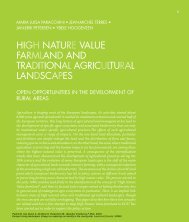The Terraced landscapes of The MalTese Islands - Landscape Europe
The Terraced landscapes of The MalTese Islands - Landscape Europe
The Terraced landscapes of The MalTese Islands - Landscape Europe
Create successful ePaper yourself
Turn your PDF publications into a flip-book with our unique Google optimized e-Paper software.
terrace walls in such fields require a good deal <strong>of</strong> maintenance and suffer badly from neglect and abandonment.<br />
This is one <strong>of</strong> the main reasons why terraces on the island <strong>of</strong> Gozo, which possess a higher proportion<br />
<strong>of</strong> exposed clay slopes, are experiencing accelerated soil erosion.<br />
Zone 4: This is the zone where terraces are occasionally prone to some flood damage during the intense,<br />
torrential, autumn rain. <strong>The</strong>se terraces retain a fair degree <strong>of</strong> moisture even during the summer drought and<br />
are <strong>of</strong>ten devoted to horticulture; with a special focus on citrus and other fruit trees. In some cases, as in Tas-<br />
Santi Valley, these terraces are not contained behind drystone walls but are retained by dense growths <strong>of</strong> the<br />
great reed (Arundo donax).<br />
Zone 5: This is the valley watercourse and the area in the immediate vicinity <strong>of</strong> the stream, which is<br />
prone to frequent seasonal flooding. Such watercourses are considered highly valuable ecosystems by scientists<br />
because they are very rare habitats in a semi-arid country. Moreover they <strong>of</strong>ten harbour rare and endemic<br />
species; a good example is the endemic freshwater crab (Potamon fluviatile lanfrancoi).<br />
Unfortunately, the high regard for watercourses is not universal. All too <strong>of</strong>ten, streams act as disposal<br />
areas, although this practice has decreased considerably over the last few years. This may be attributed to<br />
a change in perception and appreciation <strong>of</strong> such habitats amongst the general population. Moreover, such<br />
habitats enjoy the protection <strong>of</strong> environmental and planning legislation. Such protection has been increased<br />
to such an extent that it has raised conflicting issues with farmers. In fact, during the CAMP process, farmers<br />
complained that watercourses were creating problems <strong>of</strong> flood damage, since they could not legally be cleared<br />
to allow fast drainage during intense rainstorms. This was raising the level <strong>of</strong> storm-water run<strong>of</strong>f to such a<br />
height that serious soil erosion was occurring along the lower terraces located near the watercourse (Tanti et<br />
al.).<br />
3 : <strong>The</strong> spread <strong>of</strong> recreational squatter settlements in the north-west <strong>of</strong> Malta; the Ghadira and Armier sagas<br />
Recreational squatter settlements are rather curious landscape elements that have appeared near Maltese bathing areas during the last few decades. In<br />
some cases, such squatters have taken up terraced lands which were illegally sub-let to them by tenant farmers. <strong>The</strong>se settlements are composed <strong>of</strong> a series<br />
<strong>of</strong> illegally built structures, with varying degrees <strong>of</strong> permanence, which occupy state-owned land in close proximity to beaches and other bathing areas<br />
(Figure 11).<br />
Most units consist <strong>of</strong> wooden sheds, while others are mobile caravans which are permanently fixed to a spot. Some were even made up <strong>of</strong> shipping<br />
containers that were modified for temporary habitation. In time the owners modified their “caravans” with the addition <strong>of</strong> verandas, small gardens, car<br />
ports, and other embellishments.<br />
<strong>The</strong>se settlements can trace their origins to the campers who pitched their tents on the sandy beach <strong>of</strong> Mellieha Bay during the sixties and seventies.<br />
Such camps <strong>of</strong>ten lasted for most <strong>of</strong> the summer months and became an obstacle for Malta’s budding tourist industry. For this reason, overnight camping on<br />
the beach was banned in the seventies and camps were relocated to a series <strong>of</strong> terraced<br />
fields overlooking the bay. This proved attractive to other prospective squatters and, very<br />
soon, the so-called Ghadira Caravan Site grew uncontrollably. <strong>The</strong> Ghadira settlement<br />
was legally recognised during the eighties, when settlers were acknowledged as tenants,<br />
and water, sewerage, and electricity services were provided.<br />
Meanwhile, other recreational squatter sites mushroomed in prime coastal locations<br />
like Armier Bay and Cirkewwa; probably encouraged by the legal recognition granted to<br />
the Ghadira settlement. <strong>The</strong> Cirkewwa site was eventually cleared by government agencies,<br />
because <strong>of</strong> the construction <strong>of</strong> a water desalination plant, but others are proving to<br />
be far more difficult to remove.<br />
While it is widely accepted that such recreational squats are an eyesore and constitute<br />
a blight on the landscape, the residents claim that they fulfil a social need. Many<br />
Figure 11: Recreational squatter settlements at Mellieha Bay. <strong>The</strong>se are<br />
illegally constructed, semi-permanent to fully-permanent, structures<br />
which occupy state-owned land in close proximity to beaches and other<br />
bathing areas<br />
Pedroli B, Van Doorn A, De Blust G, Paracchini ML, Wascher D & Bunce F (Eds. 2007).<br />
<strong>Europe</strong>’s living <strong>landscapes</strong>. Essays on exploring our identity in the countryside. LANDSCAPE EUROPE / KNNV.<br />
state that they have rediscovered a sense <strong>of</strong> neighbourhood which has been largely lost<br />
from their home suburbs. This may explain the ironic fact that, although residents normally<br />
possess a comfortable home, they are willing to sacrifice their usual conveniences<br />
to spend some three months living in cramped quarters, albeit close to the sea.<br />
| 13




